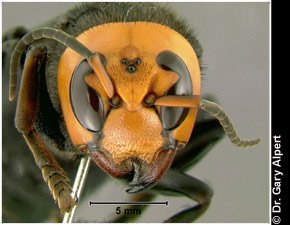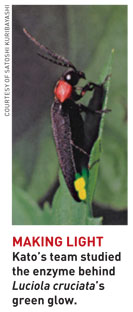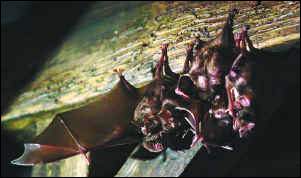The classic animal - unlike the WB Taz cartoon - is very mortal. They do have a flash temper, and often lash out and claw other TD's. The scratches are transmitting some new virus, however, since face cancer is spreading among the beasts rapidly and hideously. It was first noticed int he 1990's and is getting more prevalent.
p. 67, February 24, 2006 in Science News.
Sunday, April 30, 2006
Up, Down, Sooner, Later ...
Global warming has caused artic birds to breed earlier, but antarctic birds to breed later. p. 252, April 22, 2006 in Science News.
Th-ree bli-ind mi-ice can see again?
Blind mice can see shades of light again when implanted with a special algae gene. p. 211, April 8, 2006 of Science News.
Desperate Coral.
Corals are propagated by larvae who travel only short distances - not much more than 2 kilometers. There seems to be grave doubts that the movement to create coral gardens to rescue coral reefs will work, now. They are probably set too far apart.
Keep hoping.
p. 142 of March 4, 2006 Science News.
Keep hoping.
p. 142 of March 4, 2006 Science News.
Ick! Cannibal crickets.
The mormon crickets swarm the landscape of the American West. When they dehydrate, are low on salt, and protein, the weakest of the swarm are cannibalized by the stronger ones.
p.131 of the March 4, 2006 Science News.
p.131 of the March 4, 2006 Science News.
super sticky bacteria
In April 17, 2006 Chemical and Engineering News it's reproted that the caulobacter crescentus - a common aquatic bacteria - has glue more powerful than any known superglue. Four times stronger than superglue, this bacteria won;t move unless it wants to!
Thursday, April 27, 2006
Saturday, April 08, 2006
Mount Everest Biodiversity




A recent trip to find biodiversity in the shadow of Mount Everest teaches us more about our planet. Here are a few more photos and much more here.
Yak Killer Hornet

The giant Asian hornet (Vespa mandarinia) has earned the nickname “yak killer” from local villagers. At nearly 2 inches long, they’re the world’s largest hornets. Victims describe their quarter-inch-long stingers as feeling like a hot nail. The stinger delivers a lethal venom that dissolves human tissue, and, as the name implies, can kill a yak. Click to enlarge.
Wednesday, April 05, 2006
Bioluminecence (alt. sp. Biolumenescence)


Fireflies. We call them lightning bugs. They are not the only creatures who employ "luceferin" and "ATP" to generate light. Each species of lightning bug has its own morse code signal, and when you stand in a field on a summer night, the firework display is spectacualar.
Maybe you are old enough to recall collecting and selling the fireflies for "scientific research"?
A full article on this weird effect is in comment 1 below.
Monday, April 03, 2006
Vampire Bats Invade Louisville


Located in its HerpAquarium and stocked initially with seven bachelor bats in a colony expected to grow to 30 or 40 in a year (one of only about 20 in the United States) the furry, winged, blood-drinking mammals with razor-sharp teeth flocked in a cluster on a wooden beam near the top of the darkened exhibit modeled after an abandoned mine shaft.
They swooped down, nearly in unison, to the small pan of cattle blood lapping up several drops at a time before returning to their high roost, again huddling close, several hanging upside down.
Wing, one of the country's leading experts on bats and chairman of the U.S. Association of Zoos & Aquariums bat advisory group, said researchers believe an enzyme in the vampire bat's saliva can be helpful as a blood thinner to prevent strokes in humans.
Vampire bats are about 3 inches long with a 6- to 8-inch wingspan. They usually live to be about 9. Their range is from northern Mexico to Argentina. They colonize abandoned buildings, hollow trees, caves - they eat about two tablespoons of blood a day - nocturnal - biting into other mammals- the prey usually doesn't even know it's serving - the vampires communicate with squeaks and chatter and rely less on echolocation
Reporter Sheldon S. Shafer can be reached at (502) 582-7089.
Saturday, April 01, 2006
Weird Sea Lion

"C404" is kind of cute, with those sea-lion whiskers, soft brown eyes and furry little head. But to many he is a sea lion either from hell — or from Harvard. C404 has driven the U.S. Army Corps of Engineers at Bonneville Dam to near distraction as he and his ilk sit at the base and munch salmon gathered to continue upriver to spawn.
Subscribe to:
Posts (Atom)




